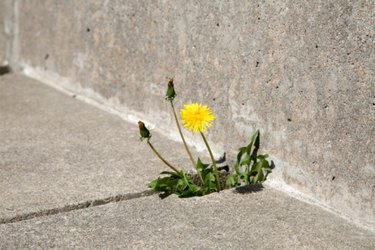
It is not hard for most people to identify a weed, but trying to define what makes a weed is not so easy. The common characteristic of weeds is that they are plants that are undesirable. Most often, this is because weeds interfere with the function of the natural environment or clash with other landscaping in a managed area. There are only a few physical and biological characteristics of plants that help to classify them as weeds.
Characteristics of a Weed
Video of the Day
Weeds may be small or large and annual, biennial or perennial. Some are edible, while others are quite toxic. A common characteristic of weeds is their relatively short growing and flowering cycles, during which they produce an abundance of seeds. They usually have the ability to grow in less than ideal environments and tend to spread quickly. For a plant to be a weed, it also should have little or no useful purpose, but that is obviously a subjective conclusion. One person's beautiful wildflower is a weed to someone else.
Video of the Day
Agricultural Definition
In an agricultural context, plants are weeds if they compete with crops for resources or reduce the ability of livestock to forage. Their presence means lower crop yields and grazing animals that are less than healthy. The time and money spent eliminating or controlling weeds are worthwhile investments for the farmer and rancher.
Suburban Definition
In residential areas, weeds are plants that do not fit in with the planned and managed landscape. They tend to be well adapted to their environment, so they grow and spread without a help. Though they grow easily, at no cost to or effort from the homeowner, they usually are not aesthetically pleasing, and the weekend gardener may spend a great deal of time and effort to eradicate them.
Ecological Definition
Ecologists consider a plant a weed if it can establish itself and thrive in a degraded habitat. When established plants are absent from an area, due to fire or the tilling of the soil, weeds are the plants that are ready to move in. They may be either native to the local environment or introduced artificially, at some time in the past. Those that are not native often have no local enemies, and therefore, no natural controls on the speed and extent at which they spread. These weeds can form dense colonies that choke out native plants and change the landscape in an undesirable way. Ecologists sometimes call these plants "superweeds."